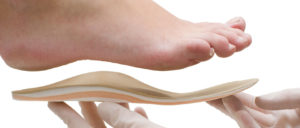
Pes Planus (Flat Feet)
What is it?
Pes planus or flat feet is when the arch on the inside of the foot is lower than what would be considered normal. This may be worse on one foot compared to the other. Pes planus (flat feet) can be mild, moderate, or severe.
What will I see and feel?

Mild and moderate pes planus (flat feet) is harder to see as the arch is lower than normal, but not completely flat on the ground. When looking from the side, the arch may only be one or two centimeters from the ground. This is not an exact measurement, but may give an idea about what to look for. When standing, the inside of the ankle may turn inwards.
With severe pes planus (flat feet), the arch is completely flat on the ground and the arch is not visible from the inside of the foot. When walking on the beach or with wet feet, the foot leaves an impression without any gaps on the inside of the foot (see Figure 1). A bone on the inside of the foot may bulge out to the side. This bone may rub against the ground or the side of the shoe causing redness, pain, and/or callusing.
Causes
By age six, the arch has developed. Prior to this age, it is normal to see kids with flat feet. Once their arch has developed, it is important to determine how the foot has developed to prevent and understand any pain in the future.
Genetics
Pes planus (flat feet) is commonly related to genetics. If you have flat feet, it is very likely that someone on either side of the family have the same feet.
Acquired
Over time, the arch may decrease. This could be due factors such as surgery, an injury, rapid weight gain (such as pregnancy), age related, or certain conditions. There are lots of structures holding the arch up. If any of these structures weaken, stretch, or move, the arch may collapse.
Why now?
You may not realize you have pes planus (flat feet) until someone tells you or pain develops. This pain may develop from a specific incident or an accumulation over time. As mentioned above, the acquired factors may cause pes planus (flat feet) later in life.
Injury or Surgery
After a major injury or surgery to the feet, they typically change because the foot is directly affected. An injury or surgery higher up, such as the knees, hips, or lower back, may not have an immediate effect to the arch height, but may change the way you are walking.
Pregnancy
With such a rapid weight change, the feet do not have time to adapt and tend to collapse. Some notice the collapse after their first pregnancy, and some not until their second or third. A common sign of arch collapse is an increase in shoe size. This increase may be in the length or width, depending on which arch collapses.
Age
Over time, the muscles weaken and the ligaments start to stretch. When this happens, the arch begins to collapse and change.
Conditions
Certain conditions may weaken the foot and accelerate or worsen the development of pes planus (flat feet). One example of this is diabetes. A complication of diabetes is neuropathy, which may hide an injury or prevent healing leading to something called Charcot Foot. This is similar to a severe pes planus (flat feet).
Treatments
Orthotics
Custom orthotics support the arch to prevent and relieve pain that is associated with flat feet. Pain may develop from overworked muscles, worn out joints, stretched ligaments, or friction from contact on the floor or shoes. Over the counter inserts are another way to support without the custom features. This may be used to prevent pain or in children growing rapidly.
Because our feet change over time, we typically recommend yearly checkups, and recasting after five years or after a major change that may affect the feet.
Strengthening
It is important to strengthen the feet to prevent further collapse over time. If consistent, strengthening may also increase the arch slightly. The effectiveness of strengthening depends on the severity and mobility of the feet.
If you would like more information, feel free to contact us!
You must be logged in to post a comment.


Comments (7)
Pingback: Patellofemoral Pain Syndrome (PFPS) | On the Ball Orthotics, Barrie
Pingback: Shin Splints (Medial Tibial Stress Syndrome) | On the Ball Orthotics, Barrie
Pingback: Anterior Tibialis Muscle Pain | On the Ball Orthotics, Barrie Ontario
Pingback: Illiotibial (IT) Band Syndrome | On the Ball Orthotics, Barrie
Pingback: Foot Tips for a New Exercise Routine | On the Ball Orthotics, Barrie ON
Pingback: Cuboid Syndrome | On the Ball Orthotics, Barrie ON
Pingback: Lower Back Pain | On the Ball Orthotics, Barrie ON